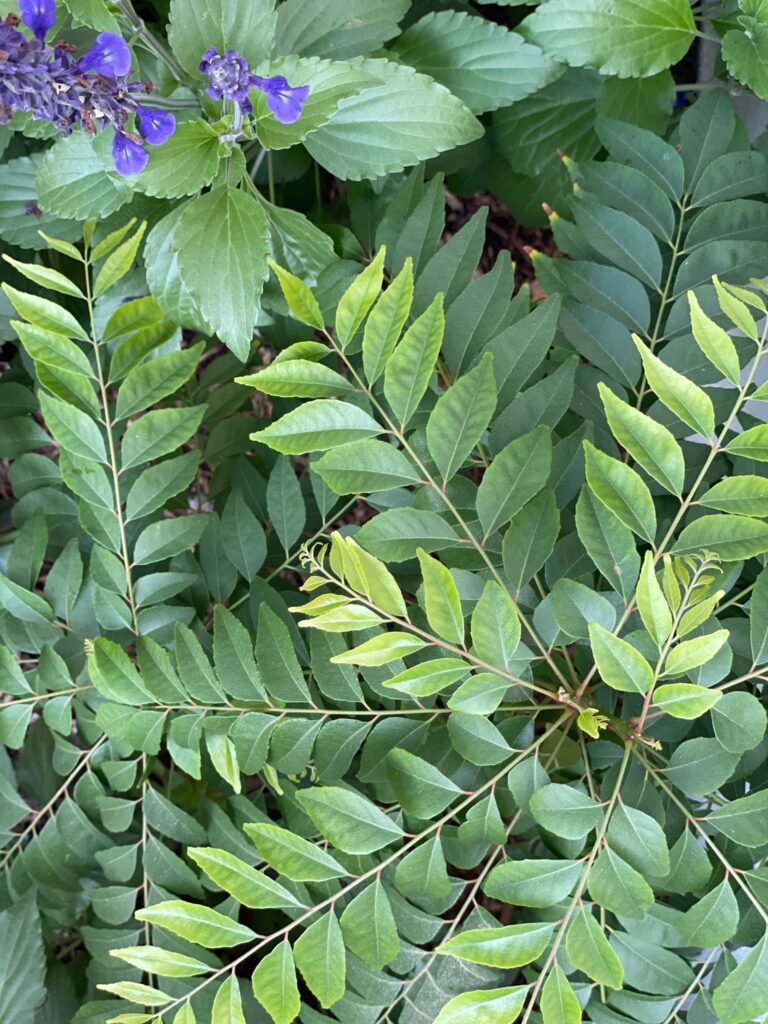One of my favorite ingredients used in Indian and South Asian cooking CURRY LEAVES!
The Basics on Curry Leaves
This week it’s all about curry leaves. Curry leaves from the curry tree/plant (Murraya koenigii) have nothing to do with curry ( a curry can exist without curry leaves) or the other curry plant. In Indian cooking, especially in the coastal Southern parts of India, curry leaves are a popular herb prized for their unique fragrance. The leaves are fried until they turn crisp and translucent in hot oil, and the oil is then used to flavor dishes. Both the flavored oil and fried leaves are consumed. Curry leaves are used in techniques like tadka, making a dal, and cooking grains, seafood, or meats. Curry leaf trees love warmth and humidity, and though L.A. isn’t humid, it responds well to heat. I’ve got two plants sitting outside in my backyard, and for the first time this year, they produced fruit (don’t eat the seeds inside the berries, they are toxic, but the berry flesh and leaves are safe).
What Do Curry Leaves Smell Like
A combination of citrusy, grassy, and burnt sulfur-like aromas. The aromas intensify during frying.
Where to Get Curry Leaves
Fresh curry leaves can be procured at an Indian grocery store, usually sold in hermetically sealed bags. You might also run into dried curry leaves; if you need to use those, I find doubling the quantity to be safer because IMO their aroma isn’t as intense as the fresh stuff. If all else fails, ask your local Indian restaurant where they source theirs, and they will point you in the right direction.
The Chemistry of Curry Leaves
Curry leaves get their special fragrance from a complex mixture of at least 22 odor-producing substances, the key one being 1-phenylethanethiol. In the case of dried curry leaves and the leaf powder, their flavor isn’t as strong because the concentration of 1-phenylethanethiol decreases rapidly. Go with fresh whenever possible.
Fat and Heat are two essential components that will help you get the most out of your curry leaves. The heat helps draw out the fragrant essential oils from the leaves, and the fat (ghee, coconut oil, olive oil, etc.) captures it (essential oils are soluble in fats). The fragrance of curry leaves will be strongest when they are first added to the hot oil, but it will mellow quickly with time. Some of the flavors stay in the leaves, some move to the oil, and the rest get into your kitchen air.
I recently learned something interesting. While dried curry leaves contain less 1-phenylethanethiol than fresh leaves, when fried, the amount of this chemical increases in dried leaves. In contrast, when fresh leaves are fried the amount of this chemical decreases. Now, this doesn’t mean that dried curry leaves will give you more curry leaf flavor on frying than fresh ones. Remember, dried curry leaves start with a significantly lower amount of these flavor molecules than the fresh leaves, so any increase in 1-phenylethanethiol is still much lower than the fresh ones. The short answer here is, if using dried, use more.




3 Responses
Hi, I recently saw frozen curry leaves and picked them up but I haven’t gotten around to using them. Any advice on how to sub for fresh (say in a tadka)?
I live in Westchester County near New York City, so although my curry leaf bushes do well during the summer months, in early fall I need to bring them inside. Although I try to keep the soil moist — not soaking wet — still around late January or early February, they always seem to be overwhelmed by spider mites. I spray them with Neem oil, but still the plants drop their leaves and so not recover until I am able to put them outside again when they sprout new leaves. Is there any way to prevent the spider mites from doing their worst? Should I be spraying neem oil before I see their webs? Or is there some other way of preventing the mites from proliferating?
I live in SoCal and my curry plants are outside. In winter, the leaves turn yellow and fall and I suspect this is because it behaves as a tender deciduous plant. I’ve not had a problem with spider mites with my curry plant but I have had that happen to other plants. I’ve found spraying the plant with neem oil, alcohol, and hydrogen peroxide helps. Sprays with bacillus thuringiensis is also very helpful, the toxin is only toxic to insects but not mammals. I hope this helps.